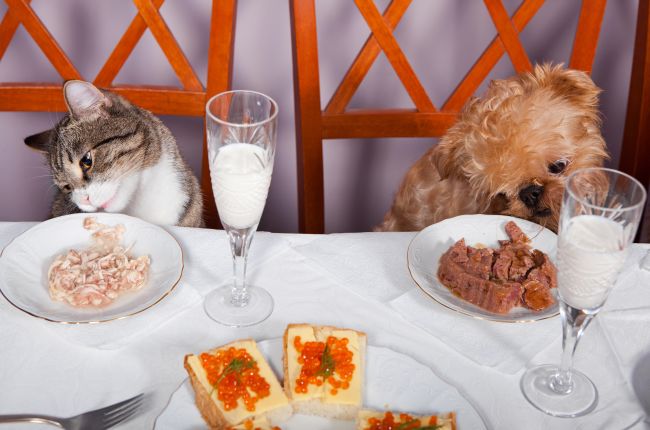Every pet owner has at some point fed their fur-baby scraps from the table. No matter how strong our resolve might by to keep our pet from begging, eventually those large pleading eyes just become too persuasive. Fortunately, most scraps we slip our animals tend to be things we know may be palatable to them such as chicken, beef, and other elements of animal skin and fat. And even though we don’t encourage the regular practice of feeding a pet from the table (because begging is not a good habit, and it stops being cute REALLY quick), here are some key rules to remember when the food-sharing does happen.
Table-feeding Rules
DOGS: When your pup is sniffing around the kitchen hoping to catch a few lonely morsels that fell to an untimely death on the floor, bear in mind which foods are safe for him to eat.
- DOs: Most meats (chicken, duck, quail, turkey and other kinds of poultry, as well as beef, lamb, pork, pork, and cooked fish, etc.) are generally safe for pets. Avoid too much meat fat, or fatty edges of bacon, beef, chicken, etc. since this can lead to health problems –veggies and lean meat are better. Our list of good leftover foods might be a helpful reference as to what kinds of fruits and veggies your dog or cat will be able to eat.
- DON’Ts: Be careful when you give your dog chicken and fish as there may be choking hazards with the small bones which can puncture the esophagus. Rice and pasta are also safe for the dog to eat, but you must be aware of the sauces it may have been cooked in. For example, onions, wine and certain oils are dangerous for your dog to ingest. (Refer to our full list of poisonous foods for pets.) Also be careful not to make the table-snacking a regular practice, since dogs can develop pancreatitis when they’ve consumed too many fattening foods. Animal health clinics complain of an enormous increase of pancreatitis attacks in pets a few days after Thanksgiving Day feasting.
CATS: Cats may not be as obvious as dogs are when it comes to begging, but they certainly show the interest and curiosity anytime you serve fish for dinner, or go to take a fresh turkey out of the oven. Before you start handing them little samples of dinner, make sure you think about whether or not the food is a safe item.
- DOs: Like dogs, cats may eat most kinds of meat and fish. Cooked poultry is a favorite snack among felines, as is a safe bet when it comes to table scraps. However, some vets agree that feeding a cat the occasional piece of fish (either raw or cooked) is completely permissible, while others caution against mercury and thiaminase levels. If give in moderation, fish present few serious health concerns.
- DON’Ts: Be careful that there are no bones in the left over fish, or in the chicken wings; pets have been known to choke and die on unforeseen bones. Though it seems harmless to feed cats tuna from cans, doing so frequently can actually lead to a condition called “yellow fat disease.” This caused by eating too many unsaturated fats which deplete a cat’s natural Vitamin E. Though some cats are drawn toward cheeses, bear in mind that they have difficulties digesting lactose, and they may go on to suffer for it later. Be aware of creamy sauces and garnishes on the plate your cat may try to sample. Are their caramelized onions, tomato sauce or what the meat drizzled in garlic sauce? Don’t let your cat be subjected to something that could be dangerous. Watch out for aging leftovers, like aging meat and rotting produce. If meat has been in the fridge for almost a week, it might cause your pet food poisoning, and should be thrown away. Remember that obesity is a common ailment in domestic pets, therefore all leftover sampling should be limited and monitored.

